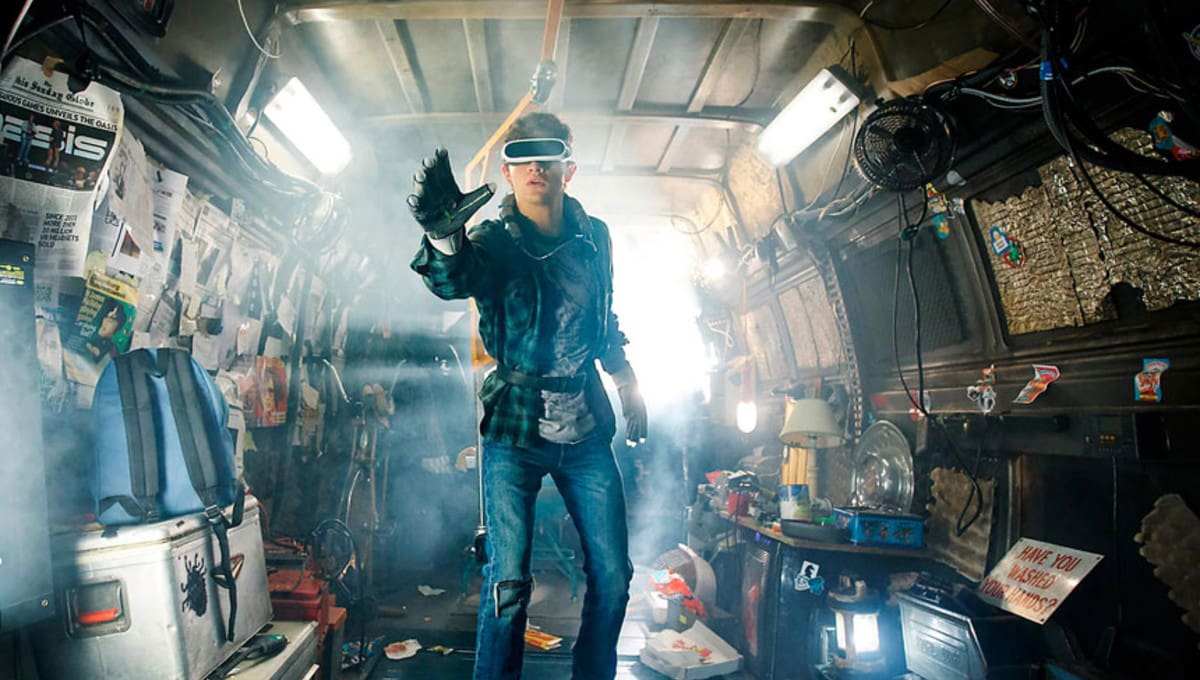Under the request of Mr. Steven Spielberg himself, there are no spoilers for Ready Player One here. Good luck finding them anywhere else too. It would take multiple viewings to catch every pop culture reference and story change from its source material, but it is abundantly clear this a passion project about why we love and need pop culture.
There’s certainly a target on its back, though. The source material has been criticized for Ernest Cline’s oversaturation of pop culture and use of villainous corporation while being a cash cow itself. That does not change in the film adaptation of the Oasis, the hyperreal virtual reality simulation created by tech genius James Halliday (Mark Rylance). Spielberg has often been criticized for his sentimentality and nostalgic flare (however unfair or shortsighted that may be) but ramps it up to 11 here while the whole world chases after an Easter egg which Halliday hid before his death. Whoever finds the egg takes sole control of the Oasis and Halliday’s company stock worth 500 billion dollars.
Against an overpopulated, dystopic backdrop in 2045, finding Halliday’s hidden treasure isn’t just a matter of winning a video game. There are real-world consequences. To some, it’s a literal matter of life or death as corporations like IOI run by Nolan Sorrento (Ben Mendelsohn) are after complete control over the economy with the egg. The main competition isn’t another business but a couple of rogue teenagers led by Wade Watts (Tye Sheridan) and his virtual alter ego Parzival, Art3mis (Olivia Cooke), each who have had something stripped from them by IOI.
That’s the nuts and bolts of Ready Player One and as far as I’ll go explaining the plot. While it may what happens in a video game may seem inconsequential and bloated by a truckload of cultural references, those are exactly what propels the film forward beyond a tired David and Goliath story.
Who has an advantage in this race against the world isn’t who has the most resources or money. Whoever wields the most knowledge about video games, film and TV holds the power. But it’s not just the ability to recite facts and understand surface-level cultural ideas, but the inventiveness in which they’re used. How much Wade and his crew know directly impacts their progress in the game. Not being familiar with certain properties has consequences.
Movies matter. Video games matter. They’re not to be taken lightly as they provide a new sense of identity, not only allowing greater connection but advocates self-worth and discovery.
Watching Wade cruise through the Oasis in the DeLorean from Back to the Future is awe-inspiring as the original source. It’s not simply an excuse to play with our favorite toys of generations past. The creativity of the characters (even the antagonists) know no bounds, just as the filmmakers themselves.
The story is as provoking and forward thinking as it is celebratory of the past, and that’s made all the more clear by surprisingly layered performances. Despite being cast outside of the book’s description of Wade, Sheridan pulls off a performance equally emotional and progressively intimate. He’s more than equipped to pull of the geeky nature of Wade and easily handles the physical requirements of an action hero. The same goes for Cooke as Art3mis.
By contrast, Mendelsohn’s work as the main antagonist is a mixed bag. His interpretation of Sorrento is slyly comedic and equally villainous. It’s the character itself that has issues as a one-dimensional and singular figure. More than the dangers of capitalist greed, that seems to be the point: It’s dangerous to be so singularly motivated. There’s still something missing, though.
But it’s Rylance that steals the show as the creator of the Oasis, turning the most powerful character into a sympathetic outcast. It’s a limited role, but his approach feels like a true throwback, seemingly channeling Bob Newhart’s dry persona. Rylance is never overwhelmed by the aura that surrounds Halliday, working best in tandem with Simon Pegg as his scene-stealing creative partner.
There are so many moving parts, Ready Player One is easily overwhelming but Spielberg does it again and provides his most visually ambitious film since A.I. If it makes you feel something, it’s job is done, proving movies are worth investing yourself in. Just be careful it’s not all of yourself.
Overal Grade: 8 out of 10



Comments are closed.